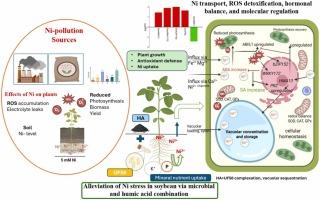Mechanistic aspect of humic acid and Pseudomonas nitroreducens strain UF50 to alleviate nickel toxicity in soybean
IF 6.2
1区 农林科学
Q1 AGRICULTURAL ENGINEERING
引用次数: 0
Abstract
Nickel (Ni): A dual-role element in plants and soil is beneficial in small doses and harmful in excess. Phytodetoxification of plants or phytoremediation of soil utilizing biological tools could be a sustainable approach in alleviating Ni-toxicity. This study explored the effect of humic acid (HA) and rhizobacteria to phytodetoxify Ni in polluted soils using soybean. The trial involved use of 1 % HA, 2.8 × 106 CFU/mL strain UF50 culture and 5 mM NiCl2·6 H2O in vitro. Ni-stress (1188.5 mg/kg Ni2 + L−1) was induced within 10 days of stress (DOS) and 4 days of recovery. Precisely, treatment with HA+UF50 enhanced antioxidant activities, soybean tolerance, growth, and biomass accumulation after 10 DOS. Untreated plants were stunted, chlorotic with increased content of superoxide anions (87 %), malondialdehyde (99.06 %), and hydrogen peroxide (1.4201-fold). Under same condition, abscisic acid (ABA) content and inducible expression rose by 1.02 and 2-fold, respectively. Particularly, treatment with HA+UF50 elevated salicylic acid and elemental concentrations of P, K+, Ca2+, and Mg2+ by 96.27, 9.56, 31.48 percent and 1.2313-fold, respectively. Inoculation of UF50 alone or in combination with HA reduced root Ni content by (30 %), and increased shoot contents by (81 %), as depicted by molecular expression patterns. Treatment upregulated expression of metal transporters GmHMA13, GmHMA14, and stress regulator transcripts GmWRKY172, GmbZIP152 coupled with down-regulation of GmAB15–1 under Ni-stress. Co-treated plants reduced ABA, enhanced SA levels and expression of GmPR2, augmenting resilience to Ni-toxicity. This result affirms the importance of neutralizing Ni-toxicity in soil and plants using HA+UF50 composite as sustainable eco-friendly alternative for phytodetoxification/phytoremediation of Ni-contaminated agroecosystem.

腐植酸和硝化假单胞菌菌株UF50减轻大豆镍毒性的机理研究
镍(Ni):植物和土壤中的双重作用元素,少量有益,过量有害。植物的植物解毒或利用生物工具对土壤进行植物修复可能是缓解镍毒性的可持续途径。本研究探讨了腐植酸(HA)和根瘤菌对大豆污染土壤中镍的植物解毒作用。试验使用1 % HA, 2.8 × 106 CFU/mL菌株UF50培养物和5 mM NiCl2·6 H2O。ni -胁迫(1188.5 mg/kg Ni2 + L−1)在应激(DOS) 10 d内诱导,恢复4 d。确切地说,HA+UF50处理提高了大豆抗氧化活性、耐受性、生长和生物量积累。未经处理的植株发育不良,叶绿素含量增加,超氧阴离子含量增加(87% %),丙二醛含量增加(99.06 %),过氧化氢含量增加(1.4201倍)。在相同条件下,ABA含量和诱导量分别提高了1.02倍和2倍。其中,HA+UF50处理使水杨酸和P、K+、Ca2+、Mg2+元素浓度分别提高了96.27倍、9.56倍、31.48%和1.2313倍。根据分子表达模式,单独接种UF50或与HA联合接种使根Ni含量降低(30 %),使茎Ni含量增加(81 %)。ni胁迫下,金属转运体GmHMA13、GmHMA14和胁迫调节转录物GmWRKY172、GmbZIP152的表达上调,GmAB15-1表达下调。共处理植株减少了ABA,提高了SA水平和GmPR2的表达,增强了对ni毒性的抗逆性。这一结果肯定了HA+UF50复合材料在土壤和植物中中和ni毒性的重要性,它是镍污染农业生态系统植物解毒/修复的可持续生态替代品。
本文章由计算机程序翻译,如有差异,请以英文原文为准。
求助全文
约1分钟内获得全文
求助全文
来源期刊

Industrial Crops and Products
农林科学-农业工程
CiteScore
9.50
自引率
8.50%
发文量
1518
审稿时长
43 days
期刊介绍:
Industrial Crops and Products is an International Journal publishing academic and industrial research on industrial (defined as non-food/non-feed) crops and products. Papers concern both crop-oriented and bio-based materials from crops-oriented research, and should be of interest to an international audience, hypothesis driven, and where comparisons are made statistics performed.
 求助内容:
求助内容: 应助结果提醒方式:
应助结果提醒方式:


